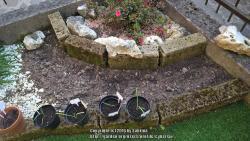Ken, I'm not sure about the bed getting narrower and how much narrower, it happens that I can't really use the spots along borders because of concrete (I guess concrete was poured to create the trough, then filled with the leftover of the buildings and some soil).
I didn't dug really deep, let's say about 50 cm, because it's too hard to dig. The deeper the harder. The spade (a small spade because the trough is not that large) bent the last time I tried to dig big holes for planting. When the soil is dry it's like a rock but deep down is always wet and it has crete consistency, I could make a lot of pottery with it. In another spot of the garden, in an another trough, some roots are going up instead of down. I guess that's because they don't have room for doing it.
The adult DLs did well for the firts two year, starting the third (the past, currently) they started to show iron deficiency. Poor flowering. But I cant' amend in between them. So for this empty bed I'd like to have a better soil, with all the limits I know are there. At least something I can work better and that lets plants take all the elements they need to survive.
You are right, nothing beats real "dirt", so I will try to amend it with manure or compost. If I could just make a layer of it and let it be it would be great, less work for me and happy plants when time will come. I know I say many wrong things because of my ignorance, so I'm happy to read all your good advices. Just take me by the hand and show me! If sulfur it's better than iron and it costs less well, that's what I will use. Or maybe it's not necessary using manure or compost?

